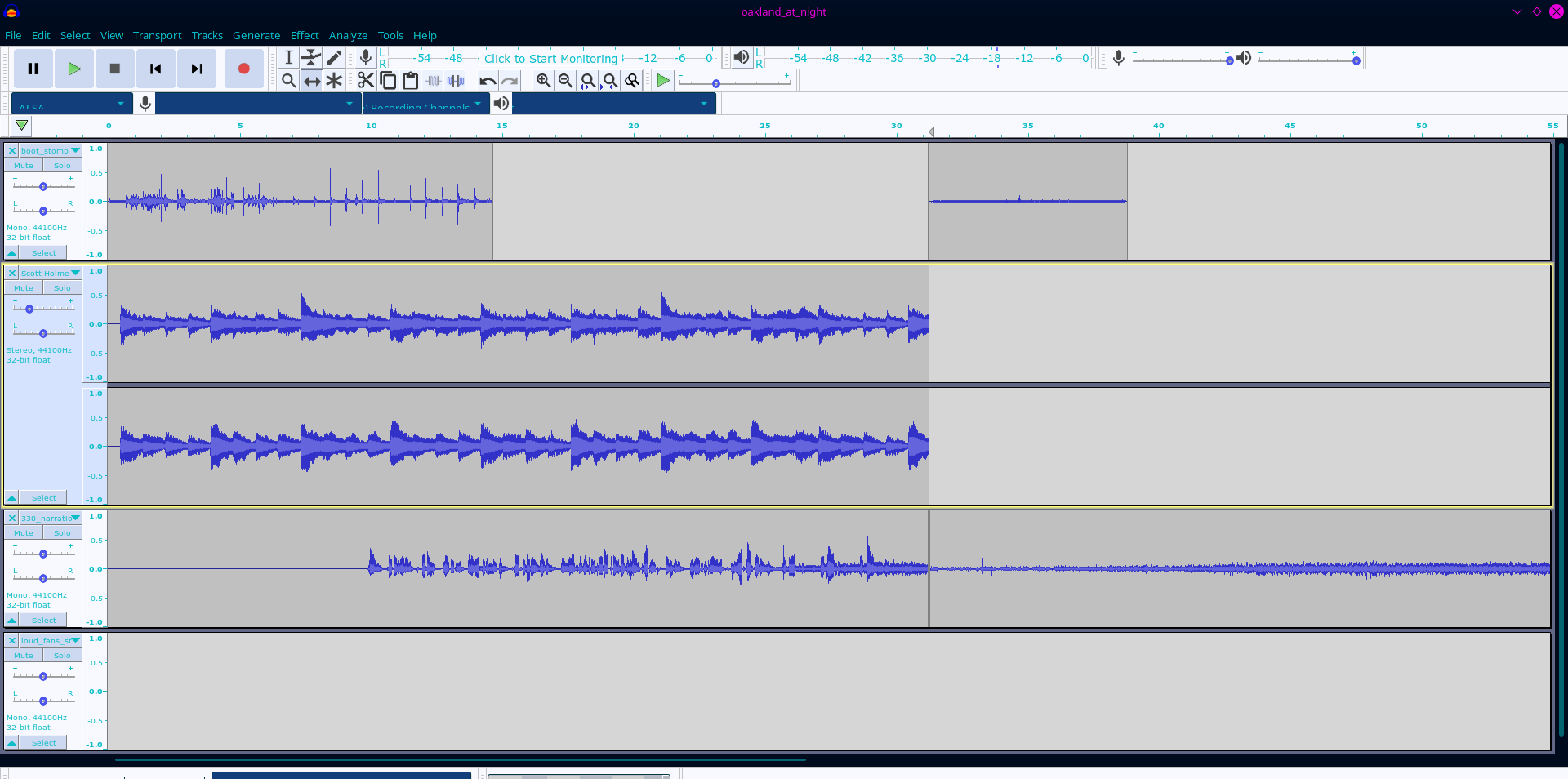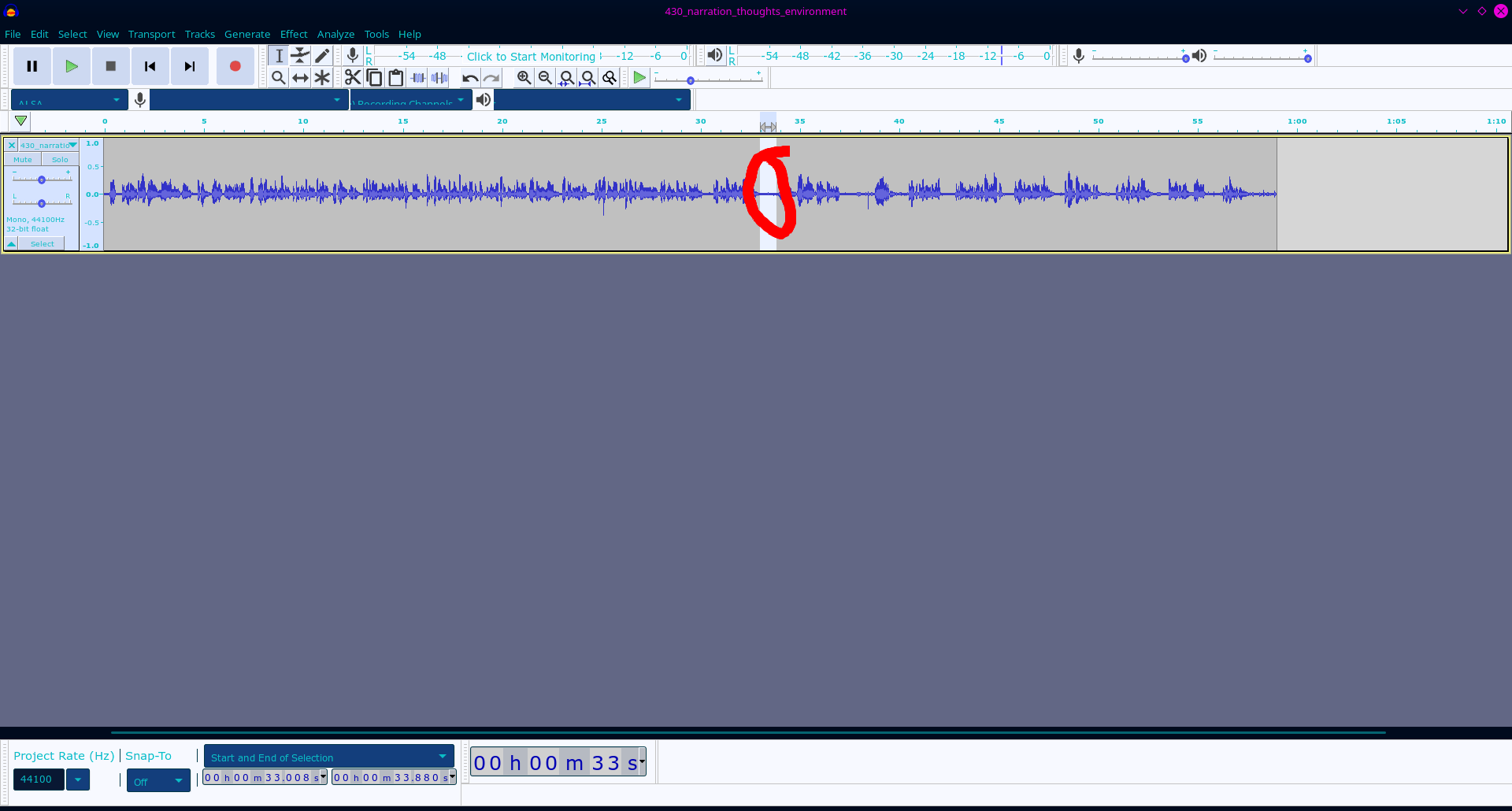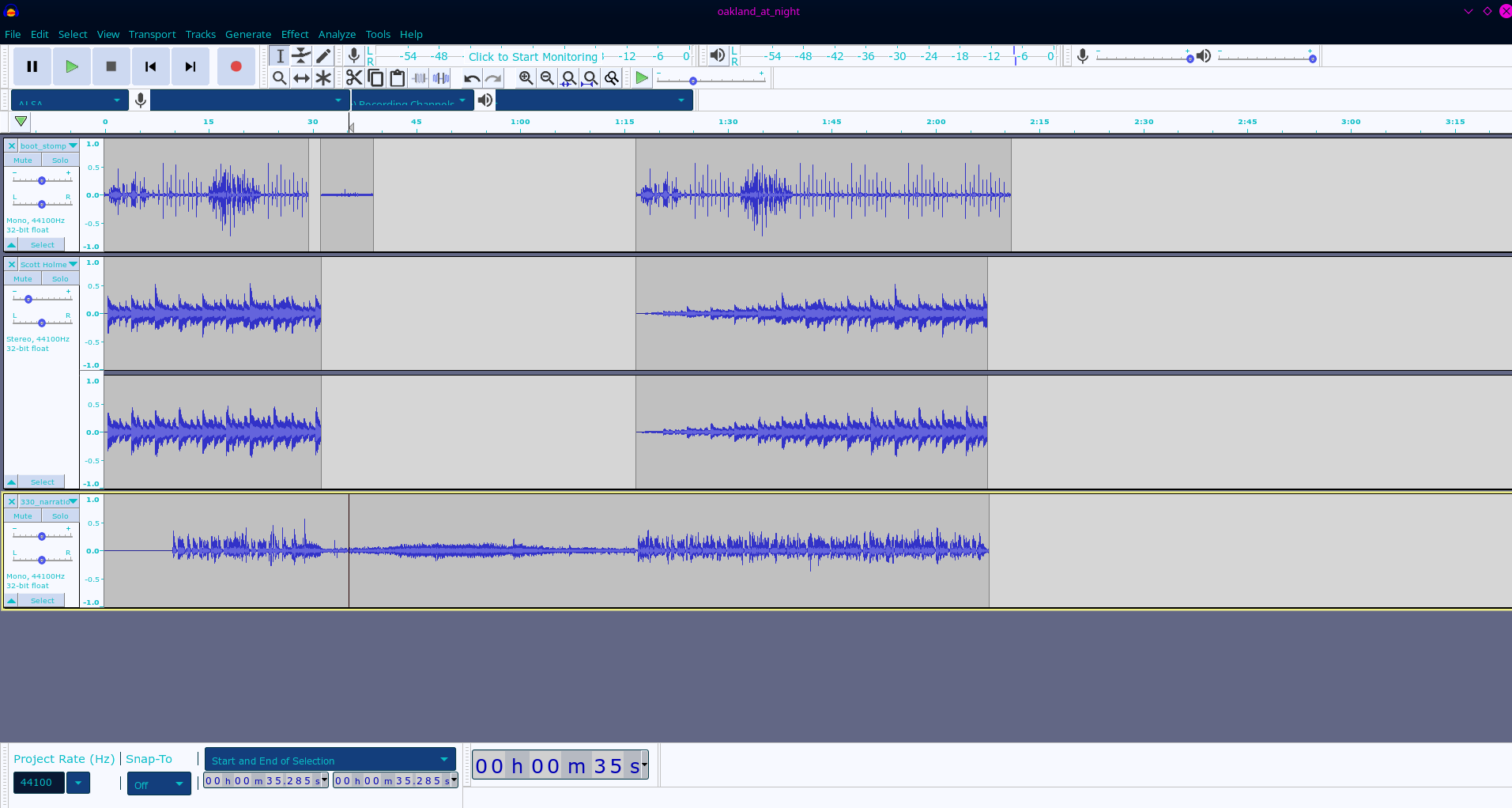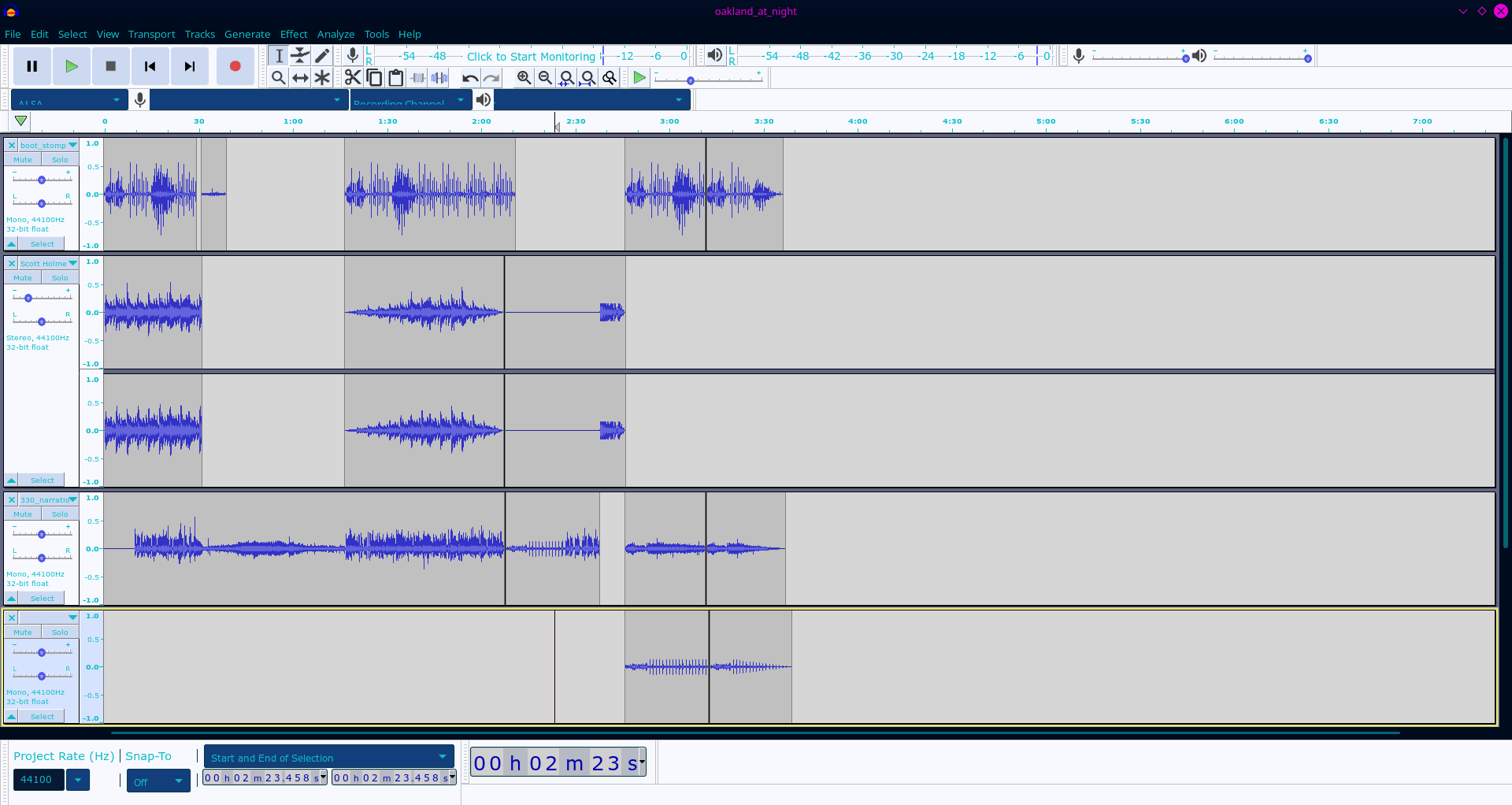Creating this narrative was my first exposure to Audacity, or with editing sound generally. It was a truly case study in trial and error. That being said, I think I met the baseline criteria, and hit some aspirational criteria as well. With regard to baseline criteria, my piece was a little over 2 minutes long at 2 minutes and 21 seconds. When recording my own sounds, beyond just doing the character lines, I also recorded the work session sounds myself. In doing so, I was able to get clips of my desk lamp being clicked on/off, which I used as a signal of the definitive start and end to the piece. I found the fade-in and fade-out effects to be useful for guiding transitions in the narrative, especially in moments moving from the person’s real life work session to the train of thought. The envelope tool was another key aid, especially when it came to the requirement of simultaneity of sound. I was able to lower the train sound will the announcer was talking, to allow for a sense of fore and background audio.
(Screenshot of the enveloped train noise picking up after one announcement, as well as the thunderstorm track fading in, shifting the narrative events.)

Outside of character lines, the train of thought was pretty much all sourced sound. I found the use of Freesound.org to be really straight forward with their clear marking of Creative Commons licenses. Keeping a running assets list also made the process of creating a final citations file straightforward.
To try to meet the aspirational criteria, I added some music to the work session (ironically titled “Sunny Days,” despite this being about a brainstorm), which I think made the work portion feel more alive. Other background tracks I used for consistent pacing were the train on the tracks and the passenger noise on the train. With those two tracks, I learned that crossfading the clips helped hide any looping. To convey a shift in the story via background tracks, I added the rain first fading in as a background noise, which then built to a more climatic crash of thunder. I found that panning helped with creating a 3D environment in my soundscape. I split passenger noise, like lines, the thoughts running around, and the shutting of windows, into left and right tracks to make the listener feel like they were standing in the middle of the train aisle, with passengers on both sides. Splitting the tracks allowed for slight overlap of some of the lines for the impulsive thoughts too. I wanted the thoughts to come in rapid succession, from both sides, to give a mildly chaotic feel building up the brainstorm.
(See screenshot below showing the passenger lines, with added passenger noise. The three clustered to the right are the more rapid impulsive thoughts.)

I also spent a lot of time on Audacity forums looking for advice on how to create various voice-distorting effects. I used the tips there to create the effect of the announcer’s voice over a PA system (using the Filter Curve telephone preset mixed with the Distortion walkie-talkie present). Additionally, I learned that reversing a line of dialogue, adding reverb, and then re-reversing the line creates a dream-like voice, which I used to embellish the imaginative feel of the narrative’s premise. A lot of the feedback I got from workshop centered around the idea of including more from the passengers/occurrences on the train beyond the announcements.
(Screenshot of Patrick’s really helpful feedback below!)

After that workshop, I recorded and added in the passenger lines (edited with the above-mentioned effects). With the worried thoughts, I tried to give context to the work session by having those thoughts talk about an essay that the person was working on in the beginning/end of the narrative. I also added in some noise of passengers running around the train car at one point, and generally tried to increase the ambient noise of the passengers.
I think these changes, especially the passenger voices, helped bring clarity to the work session, as well as more texture to the train segment. I showed it to friends and family before submitting, and they were able to identify the storyline with the help of the passenger lines. As a final note, with GitHub, I tried to create a repository with neat organization and detailed commit messages to get into good habits from the start. I think that definitely helped keep the final repository manageable even with the preview and first draft .mp3 files and screenshots.
Overall, given that it’s my first time using Audacity, I feel like I was able to pull together a narrative that was conceptually ambitious and fairly coherent in actuality.




 Initial Screenshot
Initial Screenshot Final Draft Screenshot
Final Draft Screenshot




















 For my first pass at Audacity, I focused on finding sounds from Audacity that I thought would fit with my soundscape. At this point, I did not even attempt the self-recording in Audacity. The main tools I worked with in Audacity were highlighting and cropping tracks, dragging tracks and moving them around in relation to each other, and the Amplify effect to make tracks quieter and louder.
For my first pass at Audacity, I focused on finding sounds from Audacity that I thought would fit with my soundscape. At this point, I did not even attempt the self-recording in Audacity. The main tools I worked with in Audacity were highlighting and cropping tracks, dragging tracks and moving them around in relation to each other, and the Amplify effect to make tracks quieter and louder.  For my full draft I sourced more sounds from Freesound, but I also started self-recording. This led me to use the Noise Reduction tool, especially on my own recordings to cancel out background noise and to make transitions sound smoother- I also used the fade in/out tools. I also used the Reverb effect on the narration to represent inner thoughts. Here, I started working with layering sounds. I also did a lot of Google searching on how to use specific features of Audacity that fit the needs of my project- like how to merge and drag tracks, what effect is best for inner thoughts, as well as trouble shooting when my play cursor wasn't moving.
For my full draft I sourced more sounds from Freesound, but I also started self-recording. This led me to use the Noise Reduction tool, especially on my own recordings to cancel out background noise and to make transitions sound smoother- I also used the fade in/out tools. I also used the Reverb effect on the narration to represent inner thoughts. Here, I started working with layering sounds. I also did a lot of Google searching on how to use specific features of Audacity that fit the needs of my project- like how to merge and drag tracks, what effect is best for inner thoughts, as well as trouble shooting when my play cursor wasn't moving. For my final version, I really focused on making the sounds as realistic as possible. Thanks to whoever asked about the envelope tool in class, I used this tool to alter the noise level at specific parts within tracks. I also worked a lot with the left and right panning of the sounds. I thought about myself in my room at from which location the sounds would have come from, which helped with the 360 degree feel. I also responded to my peer edits in this final.
For my final version, I really focused on making the sounds as realistic as possible. Thanks to whoever asked about the envelope tool in class, I used this tool to alter the noise level at specific parts within tracks. I also worked a lot with the left and right panning of the sounds. I thought about myself in my room at from which location the sounds would have come from, which helped with the 360 degree feel. I also responded to my peer edits in this final.
 This comment was really helpful in terms of altering my ending to make it more clear. After this feedback, I added another recorded piece letting the listener know that the narrator was ending the zoom and leaving class- to make it more clear. I also used the Envelope tool to make some of the louder recordings quieter and more in-line with the volume of the other tracks.
This comment was really helpful in terms of altering my ending to make it more clear. After this feedback, I added another recorded piece letting the listener know that the narrator was ending the zoom and leaving class- to make it more clear. I also used the Envelope tool to make some of the louder recordings quieter and more in-line with the volume of the other tracks. 














 The first suggestion was to increase the sound of the waves, so that they stood out more against the sound of the wind. This was an easy fix. The second suggestion was to extend the sound of the wind to the end of the narrative, to make the ending sound less empty. I accomplished this by duplicating the wind sound effect, splicing them together, and having the second half of the splice fade out when the tea kettle starts to whistle. Some feedback I got suggested that I add more elements to the ending, such as a door closing or the traveler sitting down to signal that they have accepted the tea. However, I chose not to use this feedback, as I wanted the traveler's decision to be open to interpretation.
Here is my project before these changes:
The first suggestion was to increase the sound of the waves, so that they stood out more against the sound of the wind. This was an easy fix. The second suggestion was to extend the sound of the wind to the end of the narrative, to make the ending sound less empty. I accomplished this by duplicating the wind sound effect, splicing them together, and having the second half of the splice fade out when the tea kettle starts to whistle. Some feedback I got suggested that I add more elements to the ending, such as a door closing or the traveler sitting down to signal that they have accepted the tea. However, I chose not to use this feedback, as I wanted the traveler's decision to be open to interpretation.
Here is my project before these changes:
 As well as after:
As well as after:






 (This screenshot shows the 3 main sounds that ended my piece, the landho! dialogue, the crowd celebration, as well as the cheery pirate shanty to really end it all)
(This screenshot shows the 3 main sounds that ended my piece, the landho! dialogue, the crowd celebration, as well as the cheery pirate shanty to really end it all)
 It is interesting to look back on when I first had this idea and to see which aspects I decided to incorporate in my final project. In my first attempt that I pushed to GitHub, I relied mostly on these ideas like following Santa walking through snow to the workshop and hearing elves' high-pitched voices. I was really intrigued by the idea of the silence of the walk compared to the loudness of the workshop.
By the time I submitted my first full draft (after having to redo all of the work that I had done two nights before the submission was due), I had decided to add more of a plot line to the story. I talked with my sister who works in television editing to see if she had any ideas, and she suggested that a fire start in the workshop. I thought this would be the perfect way to add more of a story while still emphasizing that this is just a regular day in Santa's life where there is always some form of chaos occurring; this helped me come up with my title, "Another Day in the Workshop." With this, I downloaded many, many sounds from FreeSound.org, and worked on layering all of my sounds to really put listeners into the scene.
Receiving peer feedback from this first full draft was extremely helpful. After reading other students' comments, I saw that I had created the story, and they were interpreting what I was trying to convey. Comments like the one screen shotted below showed me that I then needed to focus on cleaning up the editorial aspects like volume, cutting, and transitions.
It is interesting to look back on when I first had this idea and to see which aspects I decided to incorporate in my final project. In my first attempt that I pushed to GitHub, I relied mostly on these ideas like following Santa walking through snow to the workshop and hearing elves' high-pitched voices. I was really intrigued by the idea of the silence of the walk compared to the loudness of the workshop.
By the time I submitted my first full draft (after having to redo all of the work that I had done two nights before the submission was due), I had decided to add more of a plot line to the story. I talked with my sister who works in television editing to see if she had any ideas, and she suggested that a fire start in the workshop. I thought this would be the perfect way to add more of a story while still emphasizing that this is just a regular day in Santa's life where there is always some form of chaos occurring; this helped me come up with my title, "Another Day in the Workshop." With this, I downloaded many, many sounds from FreeSound.org, and worked on layering all of my sounds to really put listeners into the scene.
Receiving peer feedback from this first full draft was extremely helpful. After reading other students' comments, I saw that I had created the story, and they were interpreting what I was trying to convey. Comments like the one screen shotted below showed me that I then needed to focus on cleaning up the editorial aspects like volume, cutting, and transitions.
 This feedback was very helpful for me especially since I had not realized how incredibly loud my sound was at many points in the narrative. Once I learned about the envelope tool, it was much easier for me to regulate the volume levels of my many tracks. This reminded me of the importance of volume in setting the tone for the scene; after reading these comments, I was much more conscious of volume levels in order to ensure that the background tracks did not overpower the narrative. I also received a comment suggesting that I use background music throughout the narrative rather than only during the portion in the workshop.
This feedback was very helpful for me especially since I had not realized how incredibly loud my sound was at many points in the narrative. Once I learned about the envelope tool, it was much easier for me to regulate the volume levels of my many tracks. This reminded me of the importance of volume in setting the tone for the scene; after reading these comments, I was much more conscious of volume levels in order to ensure that the background tracks did not overpower the narrative. I also received a comment suggesting that I use background music throughout the narrative rather than only during the portion in the workshop.
 I thought this was a great suggestion, and I decided to implement it to have background music running throughout the entire narrative; however, the music depends on the location (Santa's house, outside, or the workshop). Additionally, I ended up shortening the segment of Santa walking outside after Professor Miller gave the comment in class about certain aspects of the soundscape not needing to be entirely realistic. This portion was originally 34 seconds, and I ended up cutting it to last only 14 seconds.
Here is a screenshot from my first draft where you can best see the high volume levels, lack of an introduction background track, and long segment of Santa walking to the workshop:
I thought this was a great suggestion, and I decided to implement it to have background music running throughout the entire narrative; however, the music depends on the location (Santa's house, outside, or the workshop). Additionally, I ended up shortening the segment of Santa walking outside after Professor Miller gave the comment in class about certain aspects of the soundscape not needing to be entirely realistic. This portion was originally 34 seconds, and I ended up cutting it to last only 14 seconds.
Here is a screenshot from my first draft where you can best see the high volume levels, lack of an introduction background track, and long segment of Santa walking to the workshop:
 Here is a screenshot from my final draft where you can see the incorporation of the envelope tool to regulate volume, the insertion of a background track for the beginning of the narrative, as per Payton's suggestion:
Here is a screenshot from my final draft where you can see the incorporation of the envelope tool to regulate volume, the insertion of a background track for the beginning of the narrative, as per Payton's suggestion:
 This screenshot from my final draft shows the shortened segment of Santa walking to the workshop:
This screenshot from my final draft shows the shortened segment of Santa walking to the workshop:
 In terms of criteria, I met all of the agreed upon baseline criteria with multiple self-recorded tracks, many layered tracks, source accreditation, length of more than two minutes, changes occurring in the narrative, meeting of deadlines and an intentional ending. I also achieved many of the aspirational inspirations including the use of background tracks to vary tone, panning to create a 3D effect, changing of pitch to emulate elves' voices, usage of meaningful commit messages, incorporating dialogue to structure the piece, and creating well-aligned transitions as best as I could. I also had successful interpretation by listeners as to what was happening in the narrative, as shown in my peer comments, and I definitely extended my depth of knowledge of both Audacity and GitHub.
Overall, I am very impressed with the work that I have done with this project. I could continue to work on it for weeks to try to perfect it, and I am very happy with the version that I have completed for now. I think that I created a cute story and executed it well to bring listeners to the North Pole for two minutes and thirty-six seconds.
In terms of criteria, I met all of the agreed upon baseline criteria with multiple self-recorded tracks, many layered tracks, source accreditation, length of more than two minutes, changes occurring in the narrative, meeting of deadlines and an intentional ending. I also achieved many of the aspirational inspirations including the use of background tracks to vary tone, panning to create a 3D effect, changing of pitch to emulate elves' voices, usage of meaningful commit messages, incorporating dialogue to structure the piece, and creating well-aligned transitions as best as I could. I also had successful interpretation by listeners as to what was happening in the narrative, as shown in my peer comments, and I definitely extended my depth of knowledge of both Audacity and GitHub.
Overall, I am very impressed with the work that I have done with this project. I could continue to work on it for weeks to try to perfect it, and I am very happy with the version that I have completed for now. I think that I created a cute story and executed it well to bring listeners to the North Pole for two minutes and thirty-six seconds. 

















 Abby's comment honestly made me feel the most reassured. I though my draft was terrible, but seeing her pick out the parts that I also liked, along with the ones that also needed a lot of TLC, was an honest confidence boost. I don’t think I was too aspirational, I just think I could have allocated my resources better, which would have also helped me keep my vision together more neatly than it did. As for the screen shots of my work, you honestly don’t see much change because my biggest flaw was the abrupt sound changes. I worked on volume level and blending throughout every clip, and I will show the sounds where I completed the most work.
Abby's comment honestly made me feel the most reassured. I though my draft was terrible, but seeing her pick out the parts that I also liked, along with the ones that also needed a lot of TLC, was an honest confidence boost. I don’t think I was too aspirational, I just think I could have allocated my resources better, which would have also helped me keep my vision together more neatly than it did. As for the screen shots of my work, you honestly don’t see much change because my biggest flaw was the abrupt sound changes. I worked on volume level and blending throughout every clip, and I will show the sounds where I completed the most work. 



This is a space where you'll be able to post your final-for-now thoughts on your audio unit projects, your soundscape narratives. These are both a space for you to think back on what you've learned, and how, and also to help me appreciate the work you've done (whether in successful product or ambitious process).
At a minimum, this should include:
This will be due on Tuesday, February 16th.